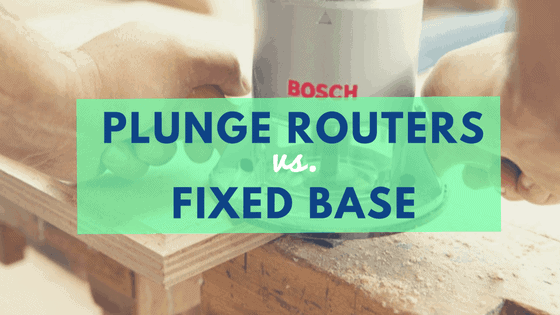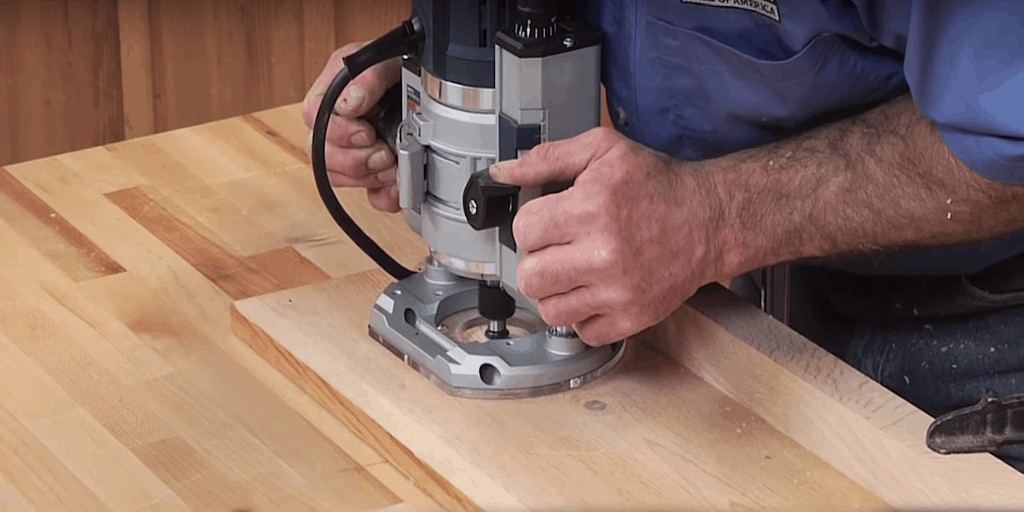Routers are an absolutely fantastic addition to any garage or workshop. Many people claim that they’re the most versatile power tool in the world, and justifiably so. With the proper router, jig, and router bits, the possibilities of what you can do with a piece (or pieces) of wood, are endless.
But what kind of router do you need?
Like with any power tool, there’s an overwhelming abundance of options out there to choose from: different sizes, horsepowers, single or variable speed motors, etc.
In this article however, we’ll talk about the two most common styles of routers: plunge and fixed base. We’ll go over what each one does, what they’re best used for, and which one will suit you and your specific needs best.
Quick Picks: Our Favorite Routers
[sc name="Plunge Router vs Fixed Base Router"]
General overview: Plunge v. fixed base routers
Plunge routers
Plunge routers move up and down on the base, which has spring-loaded arms on either side that allow the user to manually ‘plunge’ the cutting bit down into the material from above.
This is necessary when you’re working on the top of a board (as opposed to the edge), for applications such as fluting, dados and mortices, grooves and rebates, insets, etc.
However, plunge base routers can be used for edge work just as well (such as profiling edges with a round-over bit).
Related: Our Top 5 Plunge Routers
Fixed base routers
Fixed base routers are exactly that; the router is locked at a fixed location in the base, and the cutting bit cannot move - or plunge - from top to bottom. This makes doing some of the aforementioned tasks, where it’s necessary to engage the material from above, virtually impossible.
Of course, you can manually set and lock the cutting depth on fixed base routers, generally with a greater degree of accuracy than you can with a plunge router.
Fixed-base routers are great when super-precise cuts are needed (as is the case with most types of joinery), and also when mounted to a routing table.
So does the fixed base router have any advantages or real benefits?
Some of you might be thinking, “well, what does the fixed base router do that the plunge router can’t?”
In a word, nothing really.
However, fixed base routers do tend to be more accurate and they have the ability to set super-precise depth of cuts, which is important when you’re doing very tedious work like dovetail joints.
Also, they are generally smaller and weigh less, and a lot of people find that the lower profile and lower center of gravity makes them easier to maneuver and control than big, tippy plunge routers.
In addition, fixed base routers tend to be preferred over plunge base when used with a routing table. They’re simpler to adjust the depth of the bit, and like we just mentioned, they tend to be more accurate as far as maintaining their locked position than plunge routers. Also, plunge routers are a bit awkward to mount to a routing table due to their larger size, and you can’t adjust the bit depth without removing the base from the table, unless you purchase some some accessories.
So which one do you get?
Alright, let’s cut to the chase then. Which type of router is best, and which one will best suit your needs?
First, let’s mention that most of the big manufacturers out there now sell ‘combo’ routing kits; you get one motor that comes with both a plunge and fixed base, and you can easily switch between the two. Going with a combo router is really your best bet and is our general recommendation, as it eliminates having to make a decision between the two. However, combo routers are naturally a little more expensive than if you were to buy either one or the other.
If you do have to choose between the two, consider the following advice:
If you’re a novice woodworker looking to simply add another weapon to your power tool arsenal, with no exact or specific uses in mind yet, we definitely recommend going with a plunge router as your first buy. As we mentioned, they have a much wider range of use between the two, and they can always be locked in place and used as a ‘fixed-base’ anyway.
If you’re going to be doing a lot of very similar and very specific work, like profiling edges or cutting dovetail joints from a jig, and/or you plan on working strictly with a routing table, then a fixed-base will suit you well.
Here is a great, short, to-the-point video that goes over the basics of the differences between the two styles, and what each one is appropriately used for.
General things to consider before buying
One thing to kind of keep in mind before you go off and make a purchase, is that plunge routers are big, heavy, loud, powerful tools. (Well, both plunge and fixed base routers are loud and powerful and heavy, but plunge bases are usually a good deal larger).
Many people prefer the smaller size, less weight, and lower center of gravity of fixed base routers, and claim that they have better control over them than with plunge bases, which can tend to be a bit top-heavy and tippy, and a little more difficult to manage.
However, this usually comes from people whose vast majority of experience with routers has been with fixed base, so naturally the larger and heavier plunge base will fill a little more awkward the first time they use it.
Bottom line is, if you start out with a plunge router, then a plunge router is what you’ll become accustomed to, and you’ll get the hang of it in no time.
Our Top Picks: Favorite makes and models for each kind
Combo Routers:
Bosch 3 ½” 2 ½ HP corded plunge and fixed base router kit
Last update on 2024-02-05 / Affiliate links / Images from Amazon Product Advertising API
This is a nice, nice tool that you’ll absolutely fall in love with. It will set you back a fair penny, but the quality that you get is well worth it, and it’ll be in your arsenal for decades to come (hopefully).
With the 2 ½ peak-horsepower motor, it’s a powerful tool that, with the right bit and jig, can take care of just about the biggest routing jobs you can throw at it.
DeWalt 2 ¼ HP DW618PK variable speed plunge/fixed base router combo
Last update on 2023-06-09 / Affiliate links / Images from Amazon Product Advertising API
Another fantastic option. The variable speed motor makes working any sort of job an absolute delight, and is nice for beginners as well, who may find a router at peak 2 ¼ HP a bit intimidating at first use.
Also, the steel cam lock on the motor makes adjusting bit depth and swapping bases convenient and tool-free.
Fixed Base Routers:
DeWalt DW618 2 ¼ HP fixed base router
Last update on 2022-08-11 / Affiliate links / Images from Amazon Product Advertising API
Bosch 1617EVS 2 ¼ HP fixed base router
Last update on 2022-08-11 / Affiliate links / Images from Amazon Product Advertising API
Plunge Routers:
Ryobi 2 HP soft start variable speed plunge router
Last update on 2024-05-09 / Affiliate links / Images from Amazon Product Advertising API
This is an excellent ‘starter’ router. A little less peak horsepower, and a variable speed ‘soft start’ to eliminate damaging the material before you even start making your cut. It’s a great value buy that will get you off and routing until you’re ready to make the next step up.
Bottom Line
The bottom line is, if you’re the average DIY’er looking to add a first router to your garage or home workshop, and you’ve got to decide between either the plunge or fixed base, go with the plunge. Get a good 20 or 30-piece bit set with it, and you’ll be blown away at all the different things you can do.
If you don’t mind splashing a little extra cash, go with a combo kit and get a routing table as well. This is really the best of both worlds, and you’ll be able to decide for yourself when you like using one or the other.







